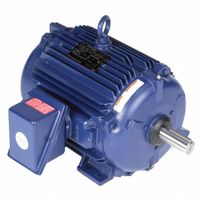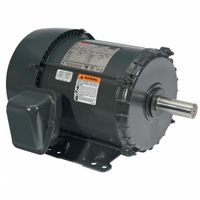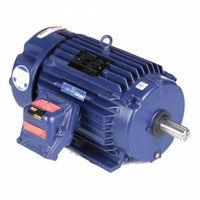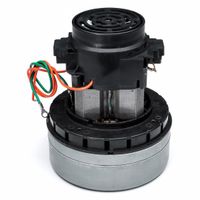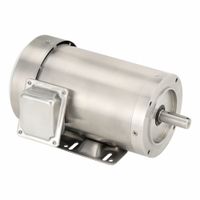Call +(254) 703 030 000 / 751 483 999 / 721 704 777
.....Read More
Frequently Asked Questions
What is an AC motor and how does it work?
An AC (alternating current) motor is an electric motor driven by an alternating current. It typically consists of two main parts: a stationary stator having coils supplied with AC to produce a rotating magnetic field, and an inner rotor attached to the output shaft that is given a torque by the rotating magnetic field. The most common type is the induction motor, where the rotating magnetic field in the stator induces a current in the rotor, creating a magnetic field in the rotor that interacts with the stator's field, causing the rotor to turn. Synchronous motors, another type, have a rotor with permanent magnets or an electromagnet that rotates in sync with the stator's magnetic field. The speed of an AC motor is largely determined by the frequency of the alternating current and the number of poles in the motor. AC motors are widely used due to their efficiency, durability, and relatively low maintenance, powering everything from industrial machinery to household appliances.
What are the different types of AC motors?
AC motors are broadly categorized into two main types: induction motors (also known as asynchronous motors) and synchronous motors.
Induction motors are the most common type of AC motor dueacing for their robust design and relatively low cost. They operate on the principle of electromagnetic induction, where the rotating magnetic field in the stator induces a current in the rotor, which then creates its own magnetic field, causing the rotor to turn. Induction motors can be further divided into squirrel-cage induction motors and wound-rotor induction motors, depending on the construction of their rotors. Squirrel-cage motors are widely used due to their simplicity and reliability, while wound-rotor motors offer more control over starting current and speed.
Synchronous motors, on the other hand, operate at a synchronous speed, meaning the rotor's speed is directly proportional to the frequency of the AC supply and the number of poles in the motor. Unlike induction motors, synchronous motors require a separate DC excitation to create the rotor's magnetic field. They are often used in applications requiring precise speed control and high efficiency, such as in power generation, industrial drives, and large pumps. Synchronous motors can also be classified into non-excited and DC-excited types.
How do you choose the right AC motor for an application?
Choosing the right AC motor involves considering several key factors to ensure optimal performance and efficiency for a specific application.
First, determine the required power and torque. This depends on the mechanical load the motor will drive, including the maximum torque needed during starting, acceleration, and continuous operation. Horsepower (HP) or kilowatts (kW) indicate the motor's power output, while torque dictates its rotational force.
Next, consider the speed requirements. AC motors come in various synchronous speeds (e.g., 900, 1200, 1800, 3600 RPM for 60Hz power) based on their number of poles. If precise speed control is needed, a variable frequency drive (VFD) compatible motor is essential.
The voltage and frequency of the power supply are crucial for compatibility. Motors are designed for specific voltages (e.g., 208V, 230V, 460V) and frequencies (50Hz or 60Hz). Mismatched power can lead to overheating or poor performance.
Environmental conditions play a significant role. Motors operating in harsh environments (e.g., dusty, wet, corrosive, explosive) require specific enclosures (e.g., Totally Enclosed Fan Cooled (TEFC), Washdown Duty, Explosion Proof) to protect internal components.
Efficiency is increasingly important due to energy costs and regulations. Look for motors with NEMA Premium Efficiency ratings or IE3/IE4 classifications, as these offer significant long-term energy savings.
Finally, consider the mounting configuration (e.g., foot-mounted, C-face, D-flange) and shaft size to ensure mechanical compatibility with the driven equipment. Bearing type and expected lifespan should also be evaluated based on the application's duty cycle and load. By systematically evaluating these factors, you can select an AC motor that meets the application's technical demands and provides reliable, efficient operation.
What are the advantages of using an AC motor?
AC motors offer several advantages that make them a popular choice in many applications. They are generally simpler in construction and more robust than DC motors, requiring less maintenance due to the absence of brushes and commutators. This also contributes to their longer lifespan. AC motors are also more efficient in converting electrical energy into mechanical energy, especially at higher power levels, which can lead to energy savings. Their speed can be easily controlled with variable frequency drives (VFDs), allowing for precise control over a wide range of speeds. Additionally, AC motors are often more cost-effective for larger applications and are well-suited for direct connection to the AC power grid, simplifying power supply requirements. Their ability to operate at constant speed under varying loads also makes them ideal for industrial machinery, pumps, and fans.
How do you maintain an AC motor?
Maintaining an AC motor is crucial for its longevity and efficient operation. Regular inspections are key, focusing on checking for unusual noises, vibrations, or excessive heat, which can indicate underlying issues. Lubrication is vital; ensure that bearings are properly greased or oiled according to the manufacturer's recommendations, avoiding over-lubrication which can lead to problems.
Keep the motor clean and free from dust, dirt, and debris, as these can impede cooling and cause overheating. Periodically check the motor's ventilation openings to ensure they are not blocked. Inspect the motor's electrical connections for tightness and signs of corrosion or wear. Loose connections can lead to power loss and heat buildup.
Monitor the motor's insulation for any signs of cracking or damage. A Megger test can be performed periodically to assess insulation resistance and detect potential electrical breakdown. Check the motor's windings for any signs of discoloration or burning, which could indicate overheating.
Finally, ensure proper alignment if the motor is coupled to other machinery. Misalignment can cause excessive vibration and premature bearing failure. Implementing a preventative maintenance schedule based on the motor's operating conditions and manufacturer guidelines will significantly reduce downtime and extend the motor's lifespan.
What is the difference between an AC motor and a DC motor?
An AC (Alternating Current) motor and a DC (Direct Current) motor are both electric motors that convert electrical energy into mechanical energy, but they differ primarily in the type of electric current they use and their operational principles.
AC motors operate on alternating current, which periodically reverses direction. They are widely used in various applications due to their simplicity, robustness, and ease of power transmission over long distances. Common types include induction motors and synchronous motors. Induction motors, the most common type, use electromagnetic induction to produce rotation. Synchronous motors rotate at a speed directly proportional to the frequency of the applied AC.
DC motors, on the other hand, operate on direct current, which flows in only one direction. They are known for their precise speed control and high starting torque, making them suitable for applications requiring variable speed and fine control, such as electric vehicles, robotics, and industrial machinery. DC motors typically use a commutator and brushes to convert the DC into an alternating current within the motor's windings, thereby creating a continuous rotational force.
Key differences lie in their construction, speed control mechanisms, and typical applications. AC motors often use fewer brushes or no brushes, leading to less maintenance, while DC motors traditionally rely on brushes and a commutator, which can wear out. Advances in technology, such as brushless DC (BLDC) motors, have mitigated some of these traditional distinctions by using electronic commutation.
How do you troubleshoot common AC motor problems?
Common AC motor problems include overheating, excessive vibration, unusual noises, and failure to start. Overheating can be caused by overloading, poor ventilation, or faulty bearings. Troubleshooting involves checking the motor's load, ensuring adequate airflow, and inspecting bearings for wear. Excessive vibration might indicate misalignment, an imbalanced rotor, or loose mounting bolts. Solutions include realigning the motor and load, balancing the rotor, or tightening mounting hardware. Unusual noises, such as humming, grinding, or buzzing, can point to issues like worn bearings, loose windings, or electrical faults. Inspection of these components is necessary. If a motor fails to start, potential causes include power supply issues, open circuits, or a seized rotor. Checking the power source, testing circuits for continuity, and manually rotating the rotor can help diagnose the problem. Regular maintenance, including lubrication, cleaning, and electrical checks, is crucial for preventing these issues and ensuring reliable motor operation.
What are the applications of AC motors in industry?
AC motors are widely used in various industrial applications due to their efficiency, reliability, and versatility.
One primary application is in **pumps and fans**, where AC motors drive fluid movement in HVAC systems, water treatment plants, and industrial cooling. They are also crucial in **conveyor systems**, facilitating the movement of materials in manufacturing, mining, and logistics, from assembly lines to baggage handling.
In **machine tools**, AC motors power lathes, mills, and drills, offering the precision and speed control needed for manufacturing. They are integral to **compressors** in industries like refrigeration, oil and gas, and manufacturing, providing compressed air for various operations.
Furthermore, AC motors are essential in **material handling equipment** such as cranes, hoists, and lifts, enabling the movement of heavy loads in construction, ports, and warehouses. Their robust nature and ability to handle varying loads make them ideal for these demanding tasks. The textile industry also heavily relies on AC motors for spinning, weaving, and dyeing machines, where consistent speed and torque are vital for production quality.
Finally, in **renewable energy systems**, AC motors are used in wind turbines to generate electricity and in solar tracking systems to optimize panel positioning. Their widespread adoption across these diverse sectors highlights their importance in modern industrial operations.
How does an induction motor differ from other AC motors?
An induction motor, also known as an asynchronous motor, is a type of AC electric motor where the electric current in the rotor needed to produce torque is obtained by electromagnetic induction from the magnetic field of the stator winding. This differs from other AC motors, such as synchronous motors, primarily in how the rotor receives its excitation.
In an induction motor, there is no external DC excitation supplied to the rotor. Instead, the stator's rotating magnetic field induces currents in the rotor conductors. These induced currents then create their own magnetic field, which interacts with the stator's field, causing the rotor to turn. A key characteristic is that the rotor always rotates at a speed slightly less than the synchronous speed of the stator's magnetic field. This difference in speed, known as "slip," is what allows the induction process to occur. Without slip, there would be no induced current and thus no torque.
In contrast, synchronous motors have a rotor that is excited by a DC current (or permanent magnets) and rotates in exact synchronism with the stator's magnetic field. They do not rely on induction for rotor current, making them suitable for applications requiring precise speed control and power factor correction. Other AC motors, like some types of commutator motors, also have different methods of excitation and operation. The reliance on electromagnetic induction and the presence of slip are the defining characteristics that set induction motors apart from other AC motor types.
What are the efficiency considerations for AC motors?
The efficiency of AC motors is a critical factor in their operation, impacting energy consumption, operating costs, and environmental footprint. Several key considerations contribute to AC motor efficiency.
Core losses, including eddy current and hysteresis losses in the stator and rotor cores, represent a significant portion of energy dissipation. These losses are minimized through the use of high-quality magnetic materials and optimized lamination designs. Copper losses (I²R losses) in the stator and rotor windings are another major factor, directly related to the current flowing through the windings and their resistance. Reducing winding resistance through thicker gauge wires or improved winding techniques enhances efficiency.
Mechanical losses, such as friction in bearings and windage losses due to air movement within the motor, also contribute to inefficiency. High-quality bearings and aerodynamic rotor designs can help mitigate these losses. Operating an AC motor at its optimal load point is crucial, as efficiency typically peaks at around 75-100% of the rated load. Operating below this range often leads to reduced efficiency.
Power factor, which measures the phase difference between voltage and current, also influences overall system efficiency. A low power factor increases the current drawn for a given power output, leading to higher losses in the supply system. Advanced motor control techniques, like variable frequency drives (VFDs), can significantly improve efficiency by allowing the motor speed to be precisely matched to the load, reducing energy waste during partial load conditions. Finally, regular maintenance, including proper lubrication and alignment, helps ensure the motor operates at its designed efficiency.


